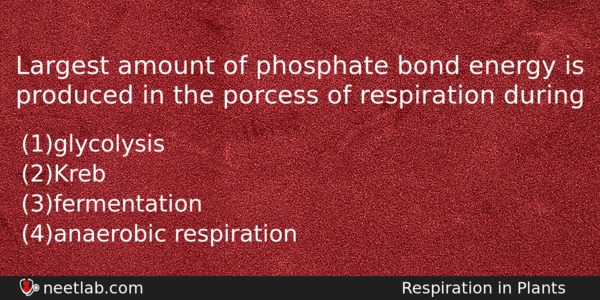| ⇦ | 
| ⇨ |
Largest amount of phosphate bond energy is produced in the porcess of respiration during
Options
(a) glycolysis
(b) Kreb’s cycle
(c) fermentation
(d) anaerobic respiration
Correct Answer:
Kreb’s cycle
Explanation:
During glycolysis, 2 moles of ATP are produced. Glycolysis is the sequence of enzyme catalysed reactions that convert glucose into two molecules of pyruvate. One cycle yields 12 ATP. Krebs cycle is the common metabolic pathway or oxidative catabolism in the aerobic respiration in mitochondria. It is involved in carabolism of protein, carbohydrates and lipids. In anaerobic respiration (respiration in absence of oxygen) only 2 ATPs are formed. Fermentation is the production of chemical energy in the form of ATP through the degradation of carbohydrates and other organic molecules in a reaction that does not require molecular oxygen.
Related Questions: - The main nitrogenous waste of Hydra is
- Histamines are secreted by
- Which single kingdom out of the following can include blue green algae
- Which one of the following is an example of Ex situ conservation?
- The embryo in sunflower has
Topics: Respiration in Plants
(184)
Subject: Biology
(4253)
Important MCQs Based on Medical Entrance Examinations To Improve Your NEET Score
- The main nitrogenous waste of Hydra is
- Histamines are secreted by
- Which single kingdom out of the following can include blue green algae
- Which one of the following is an example of Ex situ conservation?
- The embryo in sunflower has
Topics: Respiration in Plants (184)
Subject: Biology (4253)
Important MCQs Based on Medical Entrance Examinations To Improve Your NEET Score
18000+ students are using NEETLab to improve their score. What about you?
Solve Previous Year MCQs, Mock Tests, Topicwise Practice Tests, Identify Weak Topics, Formula Flash cards and much more is available in NEETLab Android App to improve your NEET score.
Share this page with your friends

Leave a Reply